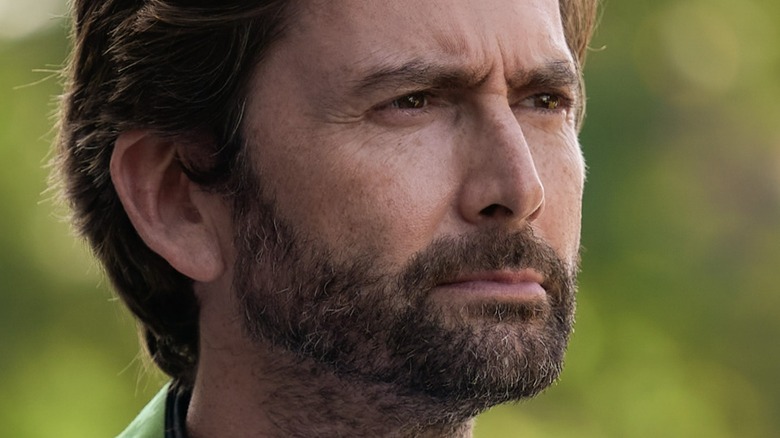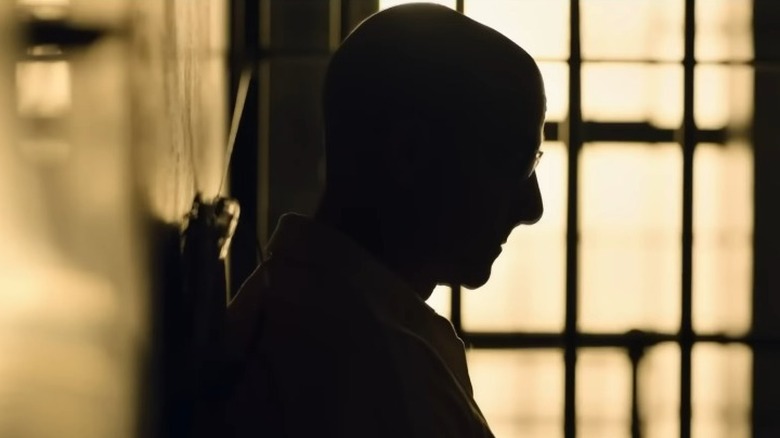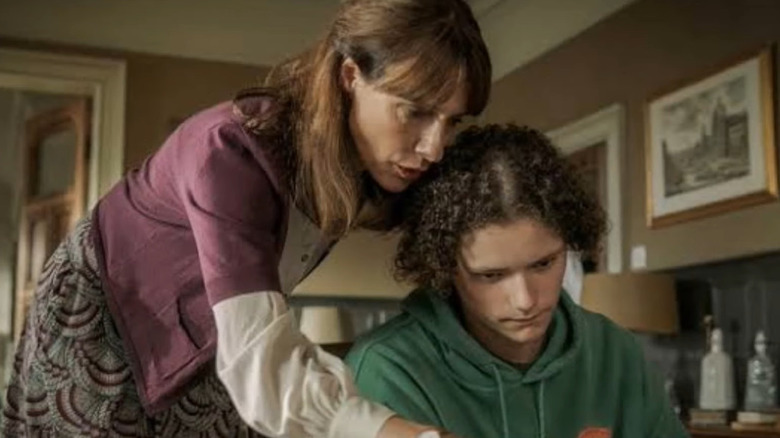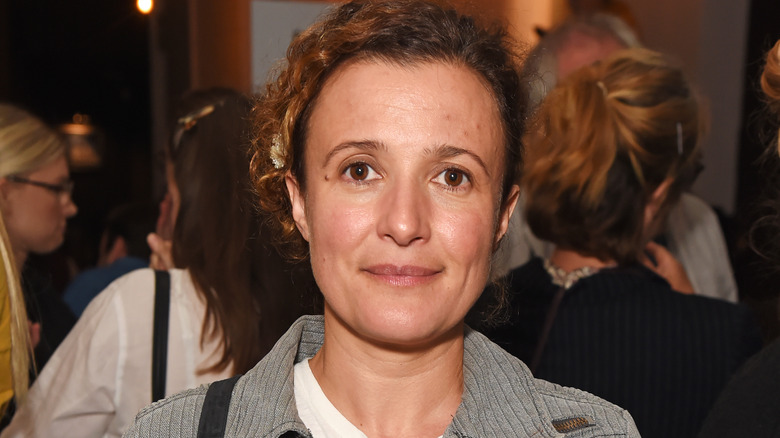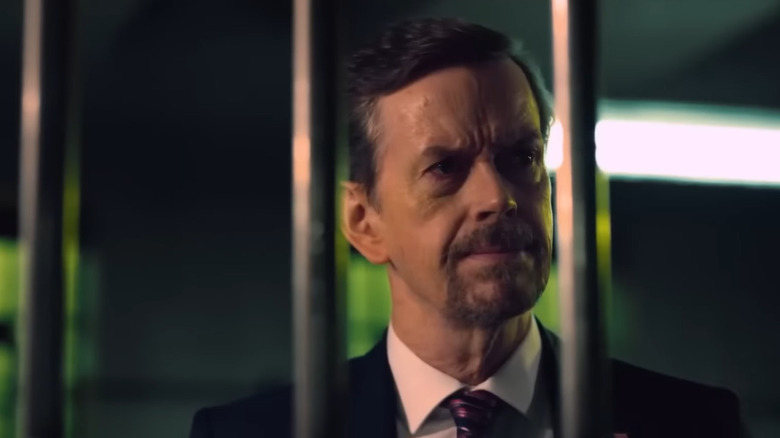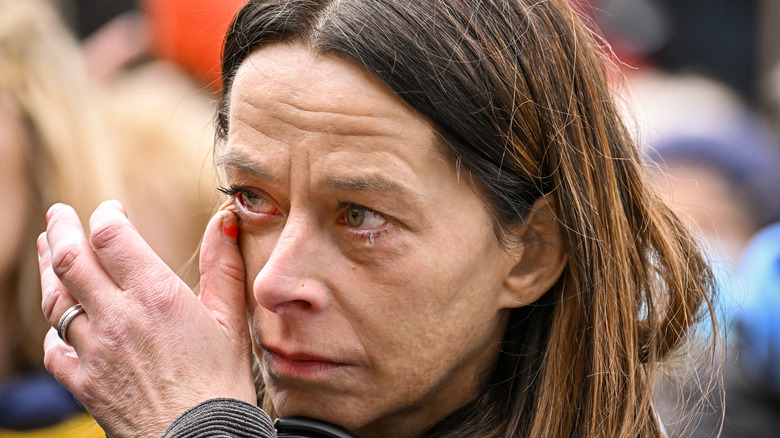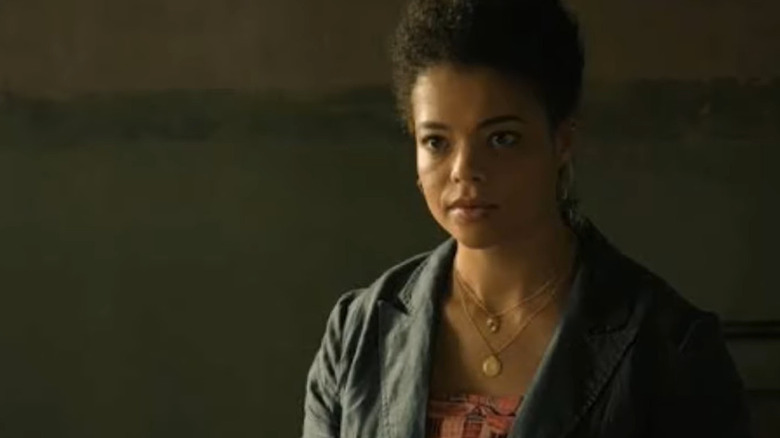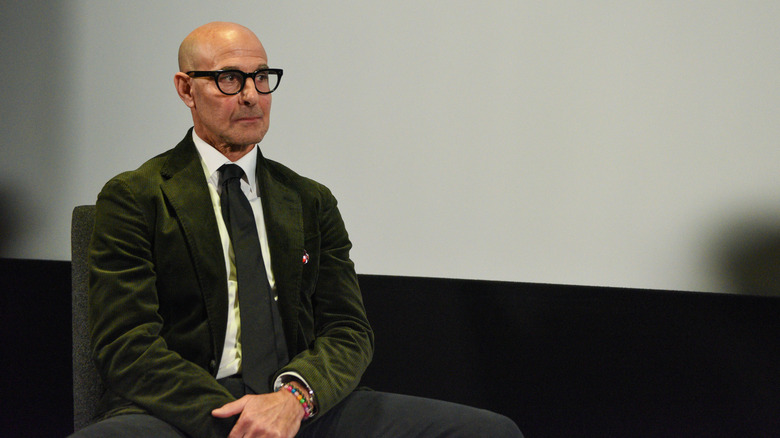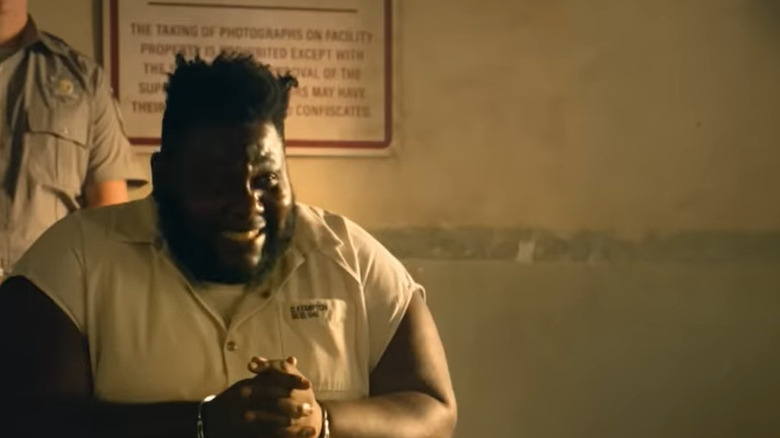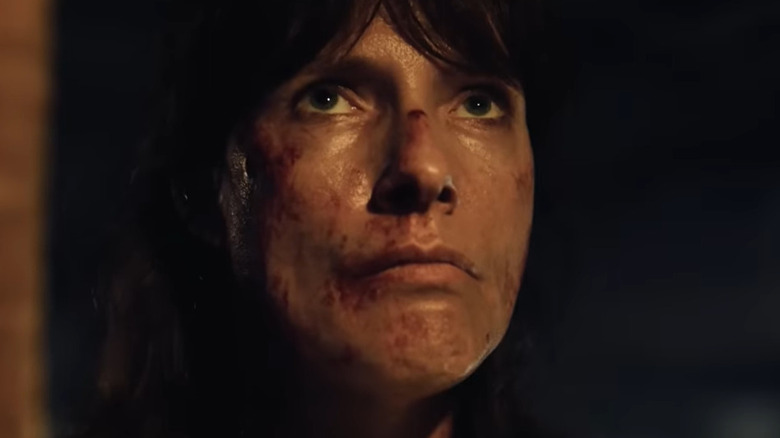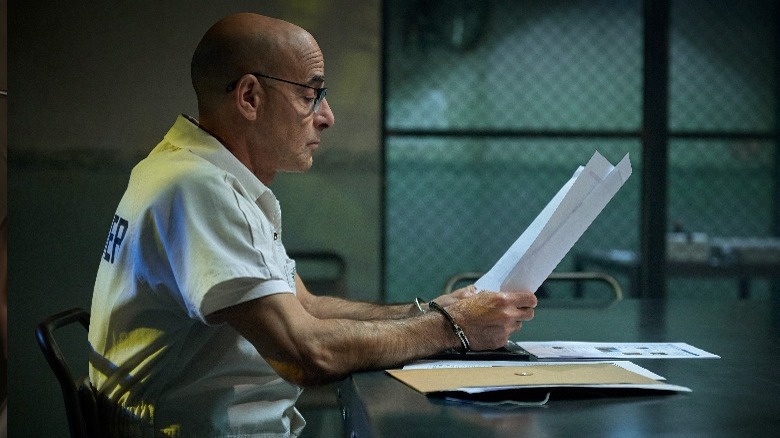The Ending Of Inside Man Season 1 Explained
Steven Moffat is a very specific creator who likes to do some very specific things with his storytelling. There's usually a human being treated like a USB drive — in this case, that would be the human recording device Dillon, played brilliantly by Atkins Estimond. Moms are a big deal, and Ben's got two, in some ways. Moffat's thoughts about gender are often very binary, which tends to revel in thought-terminating cliches. To be fair, that resulted in his greatest hit, "Coupling." In this case, however, it's nothing so funny.
"Inside Man" can be a bit of a slog in parts, even as the intricacy of its plotting and ever-increasing stakes put your heart into overdrive, although your mileage may vary widely, given how much you enjoy this particular mode of Moffat's. That mode is, essentially, puzzle boxes solved by inscrutable and insufferable people — as happens in nearly every episode of "Sherlock," "Doctor Who," and "Dracula."
Of course, a story about genius must itself be genius to succeed. If your avatar onscreen is going to prove how clever he is, you'll need to create a few puzzle boxes for him to solve. Beyond that, they better be good because that's the whole point of your story — how clever he, and by extension you, are. As the events unspool and everybody's tricking or lying to everybody else, the skillful unraveling of these lies and tricks can be inordinately satisfying. Let's see where it all ended up in "Inside Man."
Themes
One thing that's clear about this story by the end is that we are being told what is 'inside man' — as well as being shown multiple instances of a man being 'inside.'
'Inside' refers to the jailhouses where criminals mostly end up while also hinting at secret manipulations behind the scenes. An inside man could be someone helping you plan a heist or kidnapping, and the story has echoes of both.
So what is inside us? Well, the awfully dicey proposition is that we are all incipient murderers, a theory given weight by its placement by the ending montage. Of course, this is kind of wild and a little bit insulting, as it implies that self-knowledge is an illusion and that "anyone" — even a "f***ing vicar," as it's said several times — is capable of murder.
The series attempts to offer proof of this in the secrets of Mr. Grieff (Stanley Tucci), who tells us about the human spirit and then refuses to explain his own crimes. All in all, there isn't much to say at the end of the series than at the beginning, except this — If you wanted a case study to prove Grieff's point, you couldn't have a better one than Harry Watling (David Tennant).
Ben Watling
Ben (Louis Oliver) ends the series with literal blood on his hands after a bout of carbon monoxide poisoning leads him to semi-consciously beat the brittle and likable Janice Fife (Dolly Wells) nearly to death.
Ben is a tragic character almost from the jump. At first, he seems relatively normal and well-adjusted, as he is the son of a vicar and seemingly a jock of some kind. He swears that he doesn't need a math tutor, although it's not entirely clear whether this is true. However, the bond between Ben and Janice that grows over time would suggest that he did need her.
That bond takes center stage over the one he shares with either of his parents. Ben is openly a fan of Janice from the beginning, a circumstance with which she seems unfamiliar despite it happening to her on multiple occasions. After all, both Ben and his father assure her, believably, that they like her.
So we begin the story with this duo already close and already in a routine — but it ends with him seemingly beating the life out of his friend. That'll mess you up, and it's clear Ben will need extensive care in the aftermath. When last we see him, he's getting sick on the side of the road and being approached by Morag (Kate Dickie), the Scottish burglar and hitwoman. He's still confused from the carbon monoxide, but his father's already back at home, in trouble for his crimes.
Mary Watling
Mary Watling (Lyndsey Marshal) ends up as a bloody smear on the pavement after stepping in front of a bus. Why did she step in front of the bus? She was being chased by Beth (Lydia West) after breaking into Janice's house. Beth and Morag were in hiding there when she came over to drop off anything Janice had left at the Watling house, but thankfully Morag had popped out to the shops when this went down or things might have gotten (even more) violent.
Beth, ever the intrepid journalist, won't quit hounding Mary about how she knew Janice and how she'd gotten into the house — all while claiming to be Janice's housemate. Mary, fully aware that Janice was in her basement, brandishes a bread knife, which cracks Beth up until Mary connects, slicing her arm pretty badly. This turns the scene from farce to suspense pretty fast. Beth falls down a flight of stairs at one point, but it all ends out on the street.
In the end, Mary is done in by her own clear-eyed intensity. If anybody on the show has murder lurking under their skin, it's Mary, as she is able to look at the situation more rationally than her husband. Her accidental death feels a little bit like a judgment.
Warden Casey
Life in prison, in this show, is a matter of questionable loyalties. For example, Grieff pretends not to like Dillon — his only friend and a true bright spot in the unremittingly depressing circumstances.
On the other hand, warden Casey (Dylan Baker) is another representation of the show's flawed theory that everybody is possibly a murderer, and we see this when he quite openly offers to kill Grieff. Of course, Grieff is on death row, so it's a threat without a lot of heat behind it — but you can tell he means it.
This is especially apparent after we see him allow Grieff's erstwhile father-in-law to beat the pulp out of him, only to turn around and blackmail the man with the footage of the beating he'd just arranged. Casey is a real creep, played to icky perfection by Baker, and someone who stays with you after the story's done.
His desire to see inside Grieff's mind mirrors our own as we try to figure out what's going to happen and why. Likewise, the mercurial relationship between Baker and Grieff is a rollercoaster ride not unlike the one the audience experiences.
Morag
Morag continues to be hilarious and Scottish, presumably. This throwback, almost Dickensian, character is half hired killer, half exasperated administrator.
She is there to represent Mr. Grieff onscreen since he is in America, and Beth can't spend every scene on the phone with him. She also gives Beth someone to talk to and learn from. Still, even with her role and purpose so rigidly defined, the writing and acting create a figure who is unforgettable. Morag's clever dialogue, grungy humor, and absolute sociopathy are as endearing as they are terrifying, and we wonder if Beth doesn't end up with much the same impression.
As an extension of Grieff, she maintains his presence while also implying a bit of "Blacklist" flair by having henchmen all over the world. A strange Scottish killer with earnest humility about her excellent housebreaking skills, Morag is definitely a keeper if and when the show continues.
Beth Davenport
Lydia West's Beth Davenport gives us the reliably charming performance we have come to expect. In the Russell Davies series "Years and Years," she played a futuristic teen who ends up saving the world with her fellow transhumans. She appeared in his "It's a Sin" as the one straight character in an otherwise LGBTQ+ story and in Moffat's own "Dracula."
West has a girl next door appeal that places the audience comfortably in the passenger seat beside her as her story progresses. Even her opening scene, in which she is menaced by a drunk on a train, is all the more grotesque because it's happening to a Lydia West character.
In the end, Beth has seen a lot. She has accompanied multiple murderers, saved multiple lives, and is nearly killed by a vicar. We may feel a little cheated that her success in finally solving the mystery is undercut by the last-minute save by Grieff's pickaxe-wielding messengers, but at least she got herself down to the basement for her final scenes. We'd love to see this crime reporter again in any future installments of "Inside Man."
Jefferson Grieff
Jefferson Grieff ends the series still in lockup with his secrets. A mix of Red Reddington and Hannibal Lecter, the most interesting things about Grieff are the things we'll never know. Why did he kill and decapitate his wife? Where did he put her head? Why does he take the cases that he takes? For four episodes, we are teased with this information — a puzzle box mystery to contain all the other puzzles — and in the end, we're back where we started. In a lesser show, this would feel like a failure, but here it just makes us wish for more Grieff, Casey, and Morag.
Speaking of puzzle boxes, however, it's worth noting that Grieff's whole storyline — and thus the main premise of the show — is supported by his Sherlockian genius. However, as noted earlier, we only know he's a genius because people keep saying he's a genius. This can make that aspect of Grieff feel self-congratulatory and at times unearned, especially as so much of Tucci's performance is about delaying satisfaction and keeping secrets for sometimes minor reasons or none at all.
The repeated refrain of "Work it out for yourself," and then the person either trying or failing to work it out for themselves sets Grieff up as an impossible genius, and the repetition gets tiring. But Tucci never wavers, and that makes his performance magnetic.
Dillon Kempton
Dillon Kempton (Atkins Estimond), the serial killer in the death row cell next to Grieff's, is unofficially the show's MVP. He brings a sparkle to Moffat's quite serviceable voice, hitting his comedic lines with gifted timing and generally being affable while giving Grieff someone to talk (down) to. Dillon's role as a human recording device is more of a conceit than Moffat usually tosses out, but he's made Dillon such a pleasure to be around that we don't mind.
Darkly funny and alien by turns, Dillon keeps the vibe going even when the emotions surrounding it have slowed to a necessary halt. We wouldn't be surprised if he's meant to remind us a bit of Lil Rel Howery, the best friend in "Get Out." That same perfect presence brightens the story for a second or two whenever things get too dark. Dillon's a main reason we'd watch a Season 2 if things go that way.
Harry Watling
Harry Watling absolutely deserves to be in jail, which is where he ends up. While the show ties itself in knots trying to represent him as a good man in a bad situation, it fumbles in a few respects. The main one is relying on David Tennant to make the vicar human enough to be likable rather than just giving him the moral sense he's always banging on about. We see a man so addicted to his identity that it's filtered through every occasion and utterance. Watling seems to be constantly asking what a saint would do in any situation and then trying to one-up that imaginary figure by being an even better person.
It's fitting that someone like this should end up in the shoes of a murderer, but here again we see the central premise of "Inside Man" go a little weak. The series posits that while we may think of ourselves as good people, but within us all lurks a murderer. Ultimately there is no hubris so immolating as that of a 'good person' whose identity is based upon solely that.
Perhaps Moffat's right about that kind of person, but we refuse to believe everyone is one bad day away from killing someone. That's an edgy dorm-room thought and one that Moffat should have outgrown by now. Or maybe he's just telling us who he is and what his own fears are. In any case, Harry ends the show behind bars for his many crimes, talking to Grieff about what makes a murderer and still screaming to the skies that he's a good person who would never do any bad things.
Janice Fife
Janice Fife — played by Dolly Wells, whom we are duty bound to tell you was born with the very real human name Dorothy Perpetua Gatacre — is the centerpiece of the whole story. Here, she serves a role similar to the one she plays in Moffat's "Dracula" — a cold, calculating student of human nature capable of planning large-scale assaults without ever letting on.
She's a wonderful character, beautifully rendered, and her tragedy is legitimately heartbreaking. If Dolly Wells weren't such a talented Moffat favorite, we can see her murder being permanent — but let's review. After being chained in the basement, Janice and her math student slowly succumb to carbon monoxide poisoning from a heater put there by Harry. She finally admits that she was planning to report Ben for pedophilia. Although it seems she believes him by the end, a gas-addled Ben beats her within an inch of her life. The injuries to this woman throughout the series are almost impossible to look at.
In fact, you might assume she died sometime after the show ends — but a post-credits scene reveals she's made her way to America to ask Grieff and Dillon for help with her husband. He's dead but may need murdering. It's a great way to link us back to her first conversation with Ben and a truly evocative way to go out!
Will there be an Inside Man Season 2?
While news of a second season has not been released, the table seems set for another round. Dillon and Grieff are a pair we'd love to spend more time with, and you can't get better than Dolly Wells' genius Janice. We'd love to see her have an American adventure next time — made easier by the Concorde speed with which characters seem to visit and return from there — and there's a real, electric feeling in having both of the show's brilliant geniuses together in a room for even just a moment.
We're even comfortable leaving the Watlings behind if it comes to that. While David Tennant could probably read us a restaurant menu and make it fascinating, the Harry character simply doesn't have much more in him — although we'd love to be proven wrong!
If you enjoyed "Inside Man," perhaps take the binge with you. "Dublin Murders" and "Happy Valley" are highly digestible and every bit as dark, while Moffat's tenure on "Doctor Who" has a lot of the plot mechanics that made this such a thrill ride. In addition, his "Sherlock" series is almost entirely those same mechanics and tactics by the end. Finally, there's the twisty, turny, and fascinating "Dracula" if you'd like to see Dolly Wells as another unstoppable, snarky force.
